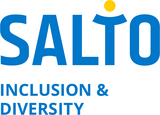Resources for Mixed Ability Youth Work - European Priority theme for 2009!
-
What & Why Mixed Ability Youth Work
Breaking barriers between young persons with and without a disability is an exciting learning experience. That's why SALTO provides information and resources for mixed-ability projects.'Young people with a disability' is a European Priority for the European Commission in 2009!

-
Labeling & Portraying people with a Disability
People with a disability are PEOPLE first, that's why it's important not to reduce them to their disability. This has some consequences for the words we use (talking about people with a disability) and the way we portray people with a disability.

-
Funding for Disability Projects
There are many different ways of getting money for your project: your organisation or participants can cover the costs themselves, you can sell cakes or organise parties, you can find a philanthropist or company that wants to support you or you can apply for funding from some funding institutions. Mostly you will be dependent on a combination of these various financial sources.

-
Traveling in a Mixed-Ability Group
There are various options for travelling in a mixed-ability group. It is very possible - but it usually takes some more time and organisation. here are some tips & tricks

-
Accessible Venues
Not only your programme needs to be accessible, but also the venue where you are going! Since there are relatively few venues that are fully accessible for persons with a disability, this means that there is a big demand for them, so you will need to book well in advance!

-
Preparing a Disability Project
As in all youth projects, it is vital to prepare the project and the people together with the young people themselves. Below you will find some concrete suggestions on how to start working both with persons with a disability and without a disability and on how to bring them together.
-
Adapting Methods for people with a Disability
Adapting methods is probably nothing new for you. Youth workers see activities or methods and adapt them to their context all the time. It is the same process (maybe a more challenging one) in adapting methods and programmes to all young people in your group.
-
Working with people using Wheelchair/Reduced Mobility
When you are developing your programme of activities for the international project (or any other project), you can adapt little things that make it a whole bit easier for wheelchair users and people with mobility impairment to take part.
-
Working with Blind people or Partially-Sighted
When you have people with a visual impairment in the group (they are not always totally blind!), you can do a variety of things to make your activity accessible and enjoyable for these participants.
-
Working with People who are Hard of Hearing
Because most of the people rely a lot on verbal communication it might not be all that easy to adapt to people that are hard of hearing. Here are some tips and tricks that could help you adapt your programme.
-
Working with people with a Mental Disability
It is not always obvious from the start that a person has a cognitive or intellectual disability. Also, there are many different types and levels of cognitive disabilities, so read this section with this variety of conditions in mind.
-
Some other Disabilities
It is impossible to cover all types of disabilities, but here are some tips for working with persons of Short Stature, Epilepsy, Speech Disorders, Cerebral Palsy, Psychiatric conditions. But as in most cases, it is best to ask the people themselves, and follow their indications.
Downloads
The following downloads are available:
- No Barriers No Borders - international mixed-ability projects - 2008 update
How to set up international projects with young people with and without a disability. With lots of tips & tricks about partnerships, funding, working with disability,... Based on SALTO TC Enable 2003
